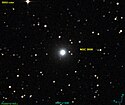NGC 3606
| Galaxie NGC 3606 | |
|---|---|
 | |
| AladinLite | |
| Sternbild | Wasserschlange |
| Position Äquinoktium: J2000.0, Epoche: J2000.0 | |
| Rektaszension | 11h 16m 15,6s[1] |
| Deklination | -33° 49′ 39″[1] |
| Erscheinungsbild | |
| Morphologischer Typ | E0[1] |
| Helligkeit (visuell) | 12,4 mag[2] |
| Helligkeit (B-Band) | 13,4 mag[2] |
| Winkelausdehnung | 1,5′ × 1,4′[2] |
| Positionswinkel | 168°[2] |
| Flächenhelligkeit | 13,3 mag/arcmin²[2] |
| Physikalische Daten | |
| Rotverschiebung | 0,010047 ± 0,000070[1] |
| Radialgeschwindigkeit | (3012 ± 21) km/s[1] |
| Hubbledistanz vrad / H0 | (126 ± 9) · 106 Lj (38,5 ± 2,7) Mpc [1] |
| Geschichte | |
| Entdeckung | John Herschel |
| Entdeckungsdatum | 20. April 1835 |
| Katalogbezeichnungen | |
| NGC 3606 • PGC 34378 • ESO 377-032 • MCG -05-27-004 • 2MASX J11161564-3349386 • LDCE 0794 NED003 | |
NGC 3606 ist eine elliptische Galaxie vom Hubble-Typ E im Sternbild Hydra am Südsternhimmel, die schätzungsweise 126 Millionen Lichtjahre von der Milchstraße entfernt ist.
Das Himmelsobjekt wurde am 20. April 1835 vom amerikanischen Astronomen John Herschel entdeckt.[3]
Weblinks
Einzelnachweise
Auf dieser Seite verwendete Medien
Autor/Urheber: Donald Pelletier, Lizenz: CC BY-SA 4.0
"Image created using the Aladin Sky Atlas software from the Strasbourg Astronomical Data Center and DSS (Digitized Sky Survey) data. DSS is one of the programs of STScI (Space Telescope Science Institute) whose files are in the public domain ( http://archive.stsci.edu/data_use.html )" This image is not a DSS's image!



